Heidesand (German Shortbread Cookies)
This post may contain affiliate links. See my disclosure policy.
A thoroughly authentic Heidesand recipe, these classic German shortbread cookies are made with browned butter that gives them their distinguishing flavor. Delicately crumbly with a melt-in-your-mouth texture, they have remained a favorite throughout Germany during the Christmas holidays for generations!
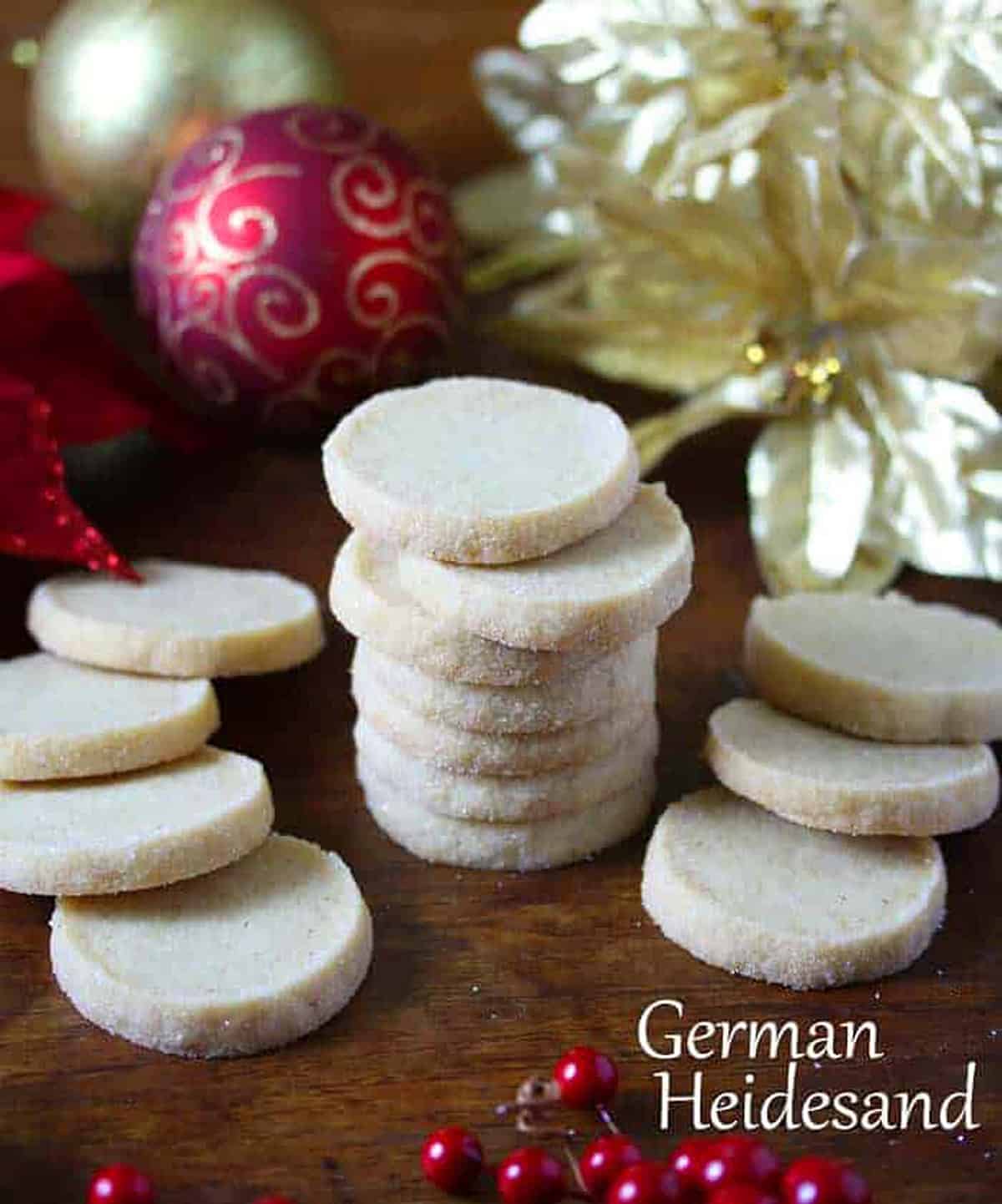
What is Heidesand?
A traditional German Christmas treat, Heidesand are delicious shortbread cookies that are made with browned butter, a feature that gives them their unique and distinguished flavor. A personal favorite, growing up in Germany my Mutti and I made these every Christmas and it has remained a family tradition ever since.
Pronounced “hi-deh-sund”, it’s an age-old classic German cookie, mostly eaten during the holiday season. Heidesand translates as “heath sand” and has its origins in the Lüneburger Heide, a beautiful heathland area in northern Germany that my family and I loved visiting. The terrain is sandy (the cookies’ namesake) and slightly hilly. In season it is covered in gorgeous purple heather. Most of it is a nature reserve and it is a popular north German tourist site. It also has historic significance, having been cultivated since 3000 BC with over a thousand Megalithic sites from the New Stone Age and early Bronze Age.

Indigenous to the area are the famous Heidschnucke, a north German breed of moorland sheep with big rounded horns. I always got a kick out of saying the name as a kid. “Hyde-shnook-eh”.
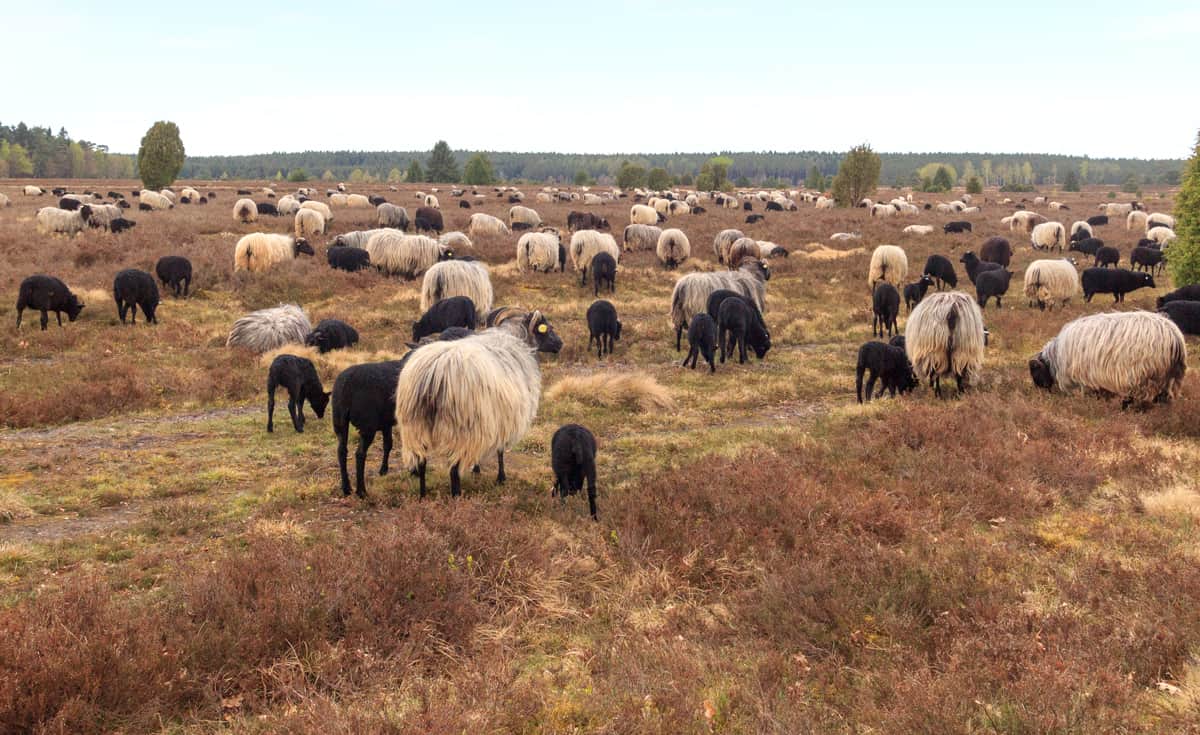
And so from this beautiful region of Germany we have Heidesand, a “sandy” shortbread cookie made with browned butter and enjoyed all over Germany during the Christmas season.
German Shortbread Cookies Variations
I love traditional Heidesand and how such simple ingredients can produce the most wonderful flavor and texture. There are a number of contemporary variations of Heidesand that you can also try, such as including the addition of some finely minced candied ginger, candied orange peel, orange zest, or rosemary.
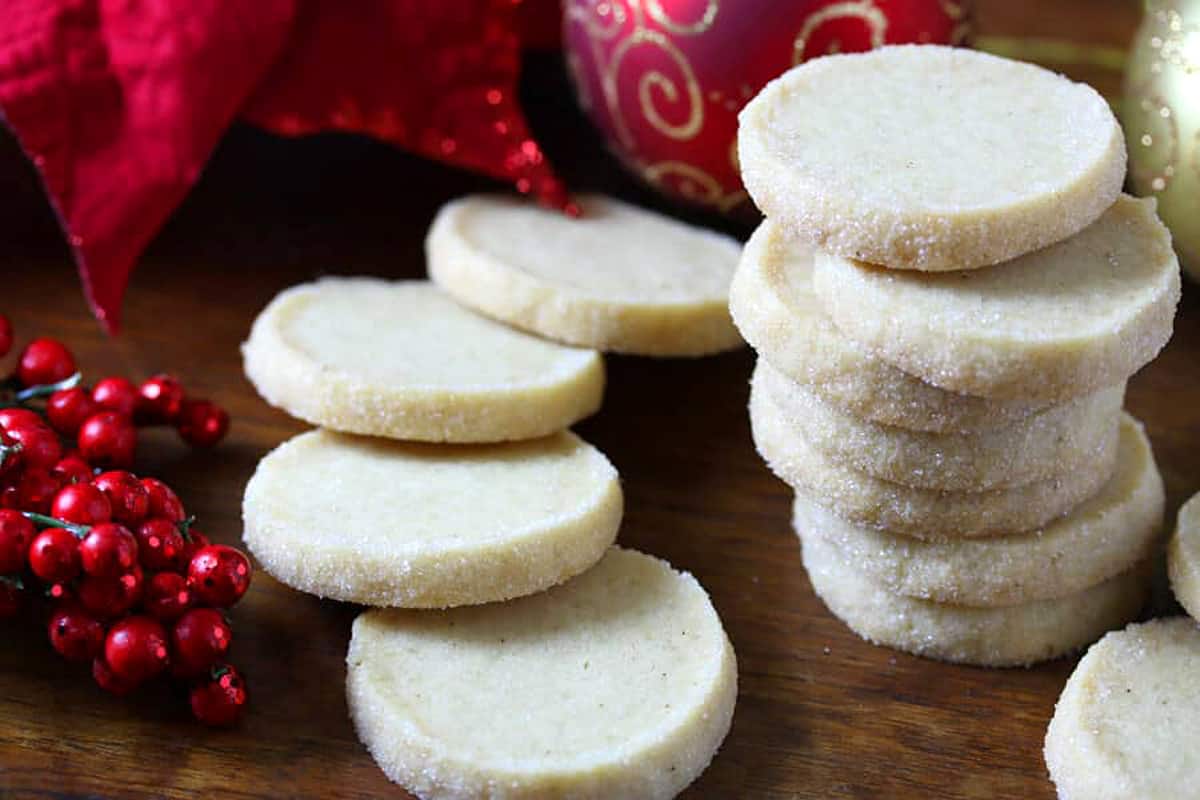
Heidesand Recipe
Let’s get started!
First let’s brown the butter. Melt the butter in a small saucepan over medium heat. Whisk the butter frequently as it begins to simmer.
The butter will begin to foam and the foam will start to subside. Continue whisking. It’s very easy for browned butter to become burnt very quickly, so keep an eye on it. Browned specks will begin to form on the bottom of the pan, emitting a lovely nutty aroma.
You want browned butter that is rich in color for the full flavor benefit. As soon as it becomes a rich brown, remove it from the heat to prevent it from burning. Let the browned butter cool completely.
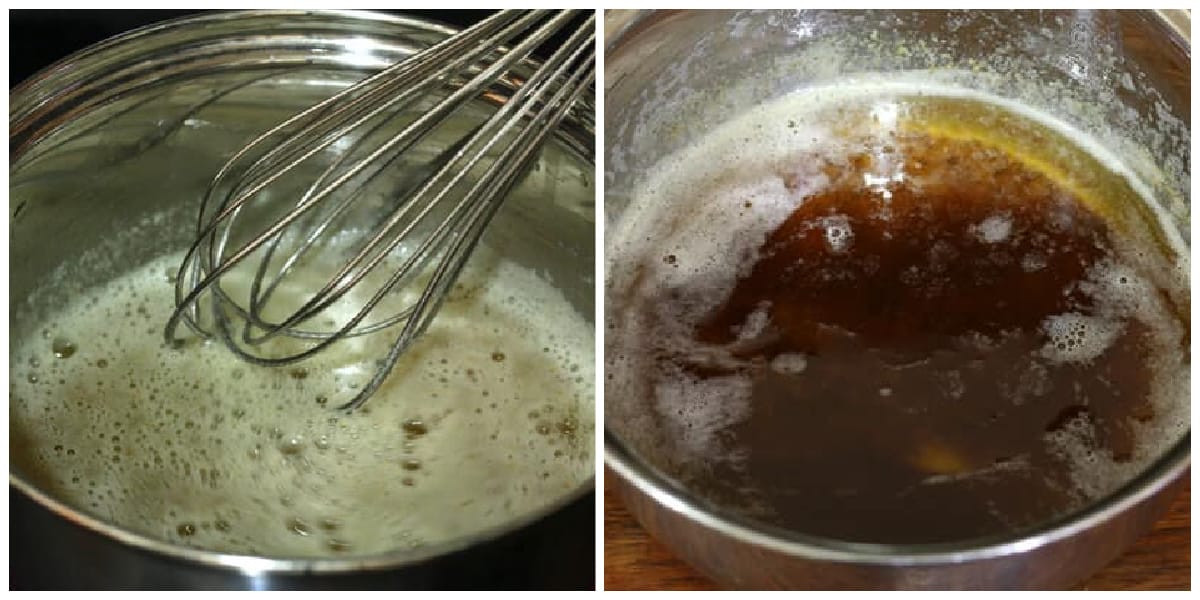
Once cooled, add the browned butter to a mixing bowl and beat until frothy.
Add the sugar, milk and vanilla extract and beat until combined.
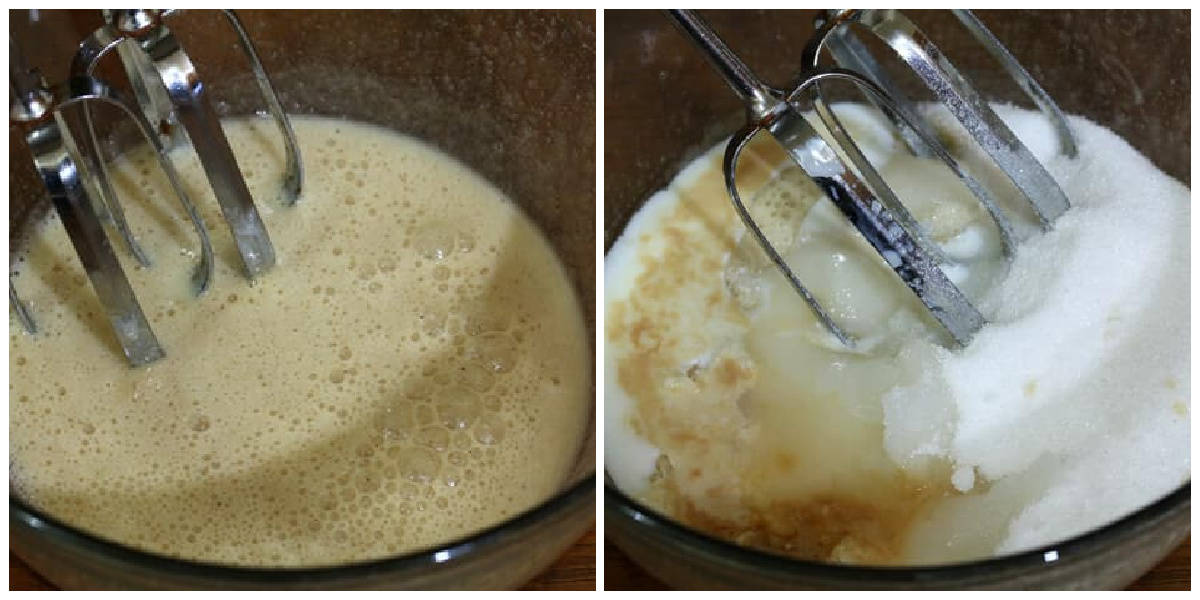
In a separate bowl, combine the flour, baking powder and salt.
Add the flour mixture to the butter mixture and beat until the mixture resembles coarse sand.
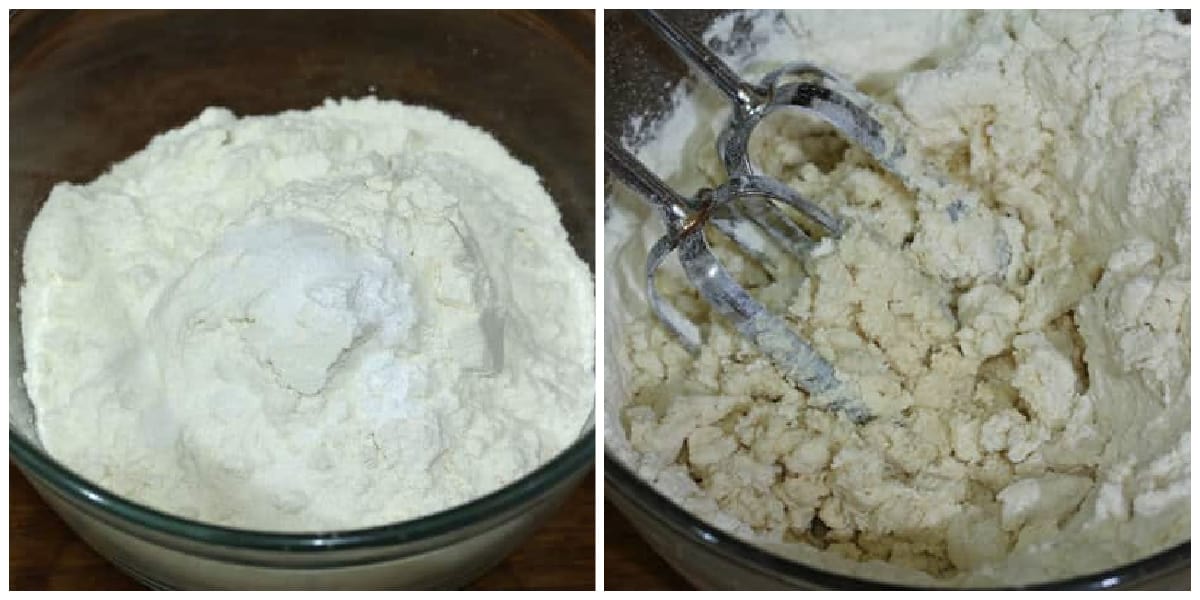
The mixture will be very dry.
Use your hands to form the crumbs into a mass of dough. The dough will be very dry and crumbly and that’s how it should be. It will just barely stick together, some parts of it breaking off. It is a bit challenging to work with but the crumbly dough is what ensures the best shortbread texture.
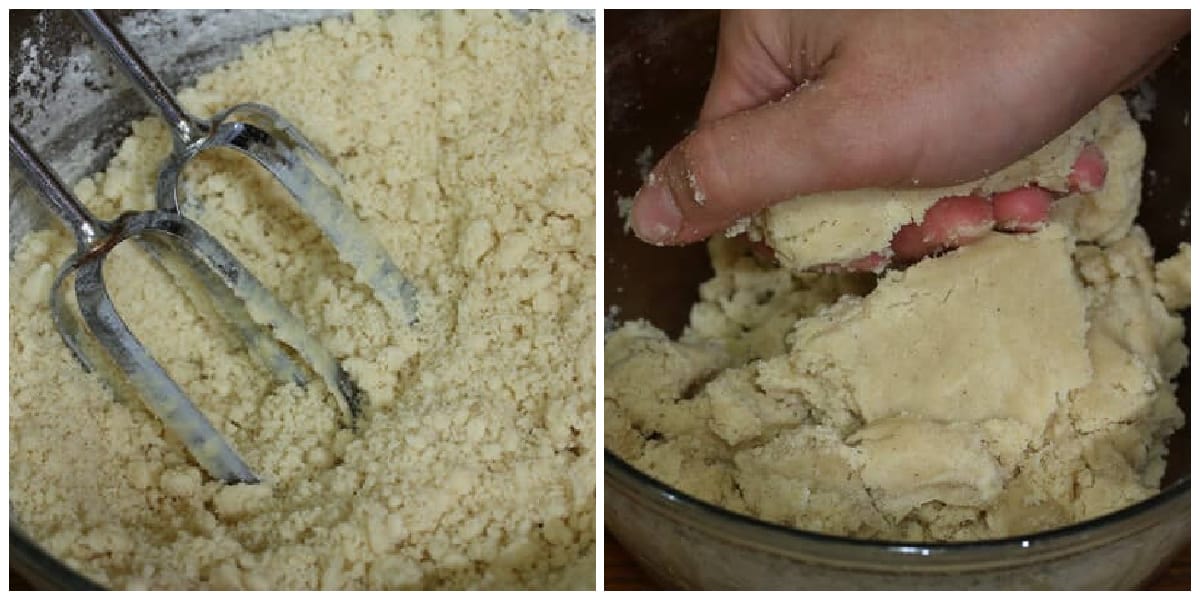
Transfer the door to a clean work surface and squish the dough together to form two logs about 1 inch in diameter. Again, the dough is dry and will take some squishing and re-squishing to get it to stay together. Don’t worry about that, once it’s chilled it will stay together.
Wrap the logs up in plastic wrap and refrigerate overnight.
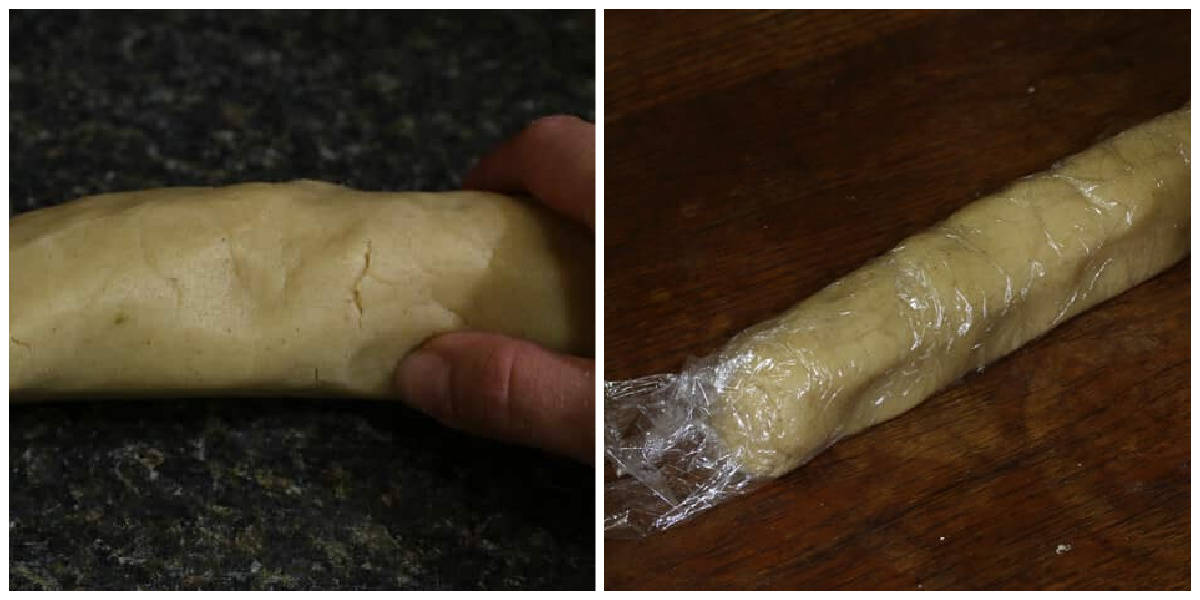
Cut the chilled dough into 1/4 inch rounds.
Traditionally the cookies are often rolled in Hagelzucker (in English, pearl sugar), very coarse and opaque chunks of sugar that don’t melt under baking temperatures. They add a nice decorative touch. I couldn’t find my stash while I was making these so had to make do with regular sugar.
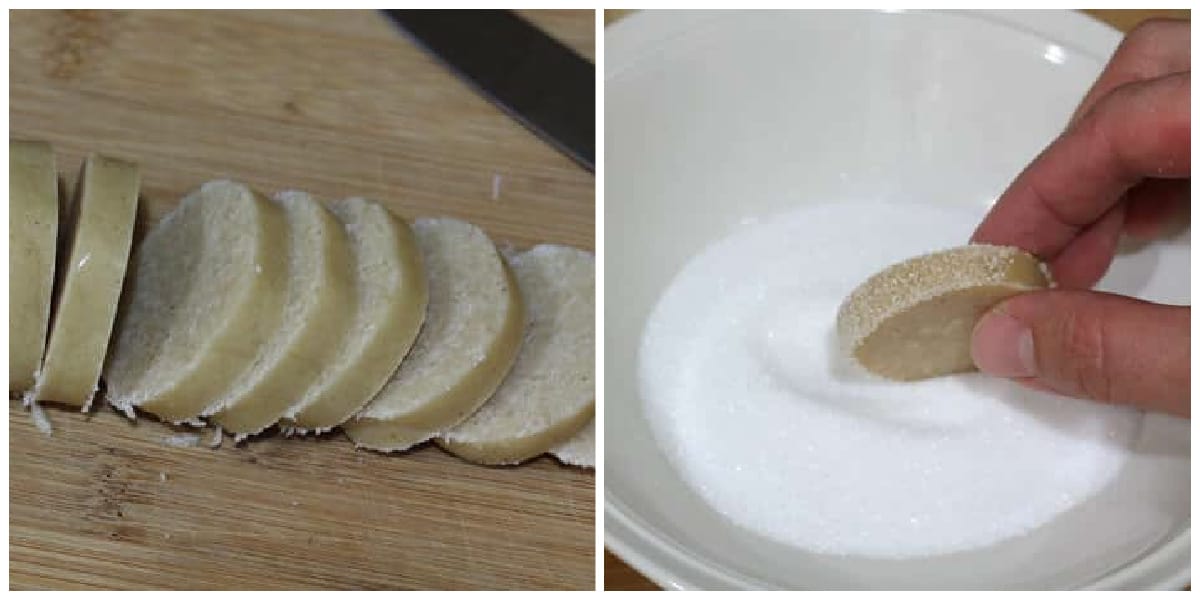
Time to bake them. In an oven preheated to 350 degrees F, bake them for about 15 minutes, rotating the pan halfways through to ensure even baking, until the edges are just barely starting to turn golden.
Let the cookies sit for a couple of minutes on the baking sheet before transferring them to a wire rack to cool completely.
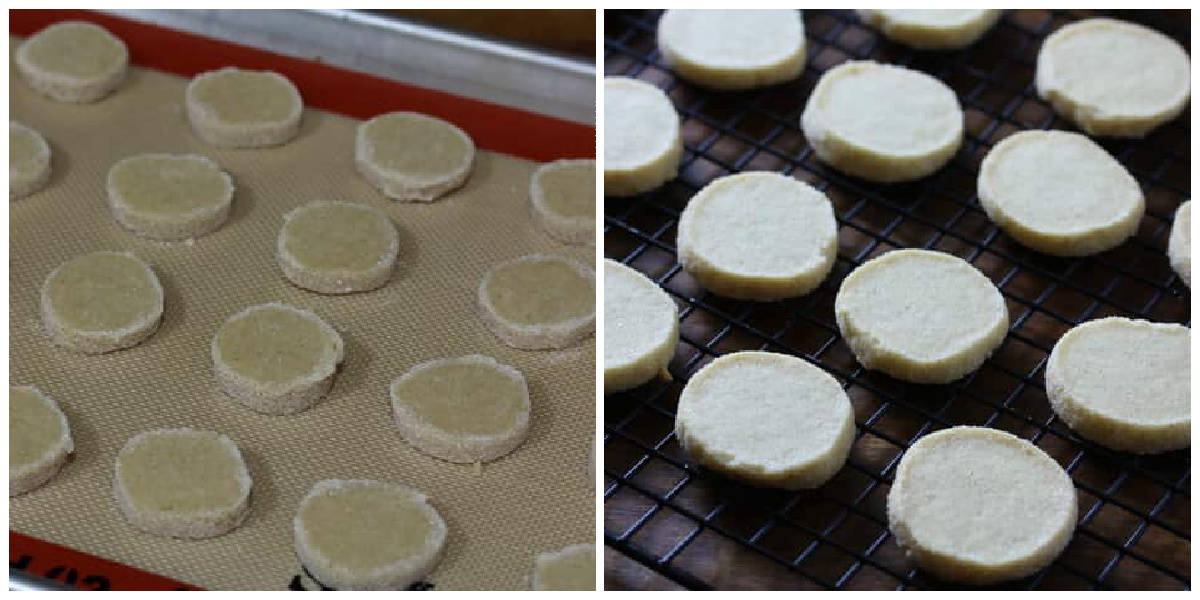
Enjoy!
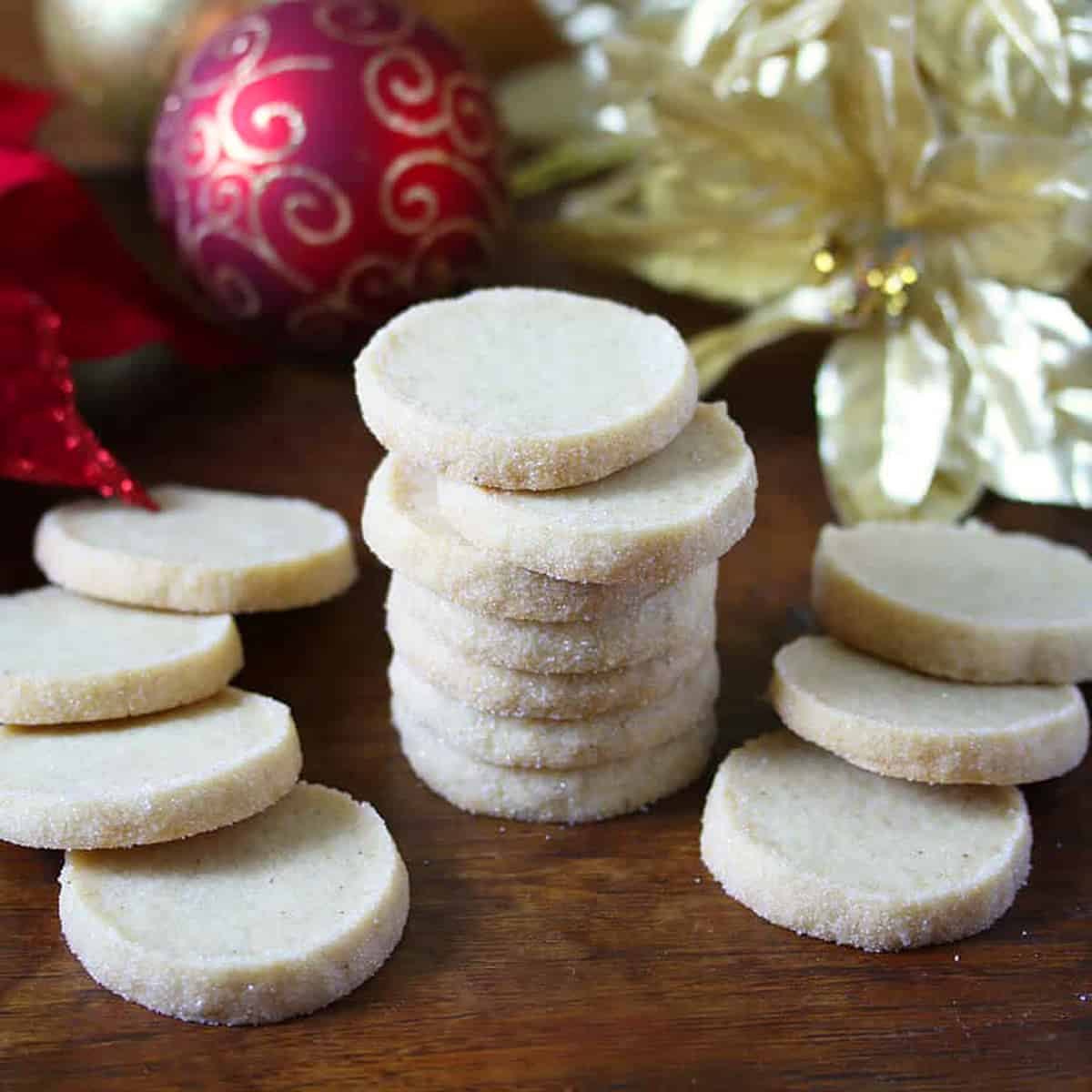
For more traditional German Christmas goodies be sure to try our:
- Stollen
- Pfeffernüsse
- Lebkuchen
- Springerle
- Gugelhupf
- Printen
- Magenbrot
- Speculoos
- Vanillekipferl
- Zimtsterne
- Bethmännchen
- Marzipan
- Marzipankartoffeln
Save This Recipe
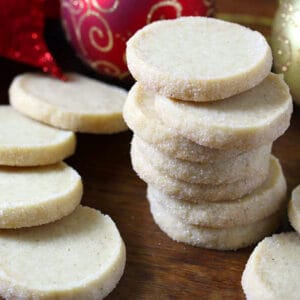
Heidesand (German Shortbread Cookies)
Ingredients
- 2 sticks unsalted butter , (1 cup)
- 1 cup white granulated sugar
- 2 tablespoons milk
- 1 teaspoon quality pure vanilla extract
- 2 1/4 cups all-purpose flour
- 1/2 teaspoon baking powder
- 1/4 teaspoon salt
- Pearl sugar for rolling
Instructions
- Melt the butter in a small saucepan over medium heat, whisking frequently as the butter comes to a simmer (simmer, not boil). Browned specks will appear at the bottom of the pan. Whisk constantly until the the butter reaches a rich brown color. Note: The butter will burn very quickly at this stage so be careful. Once the butter is a rich brown at the bottom of the pan, remove from heat and let cool completely.Once cooled, pour the butter in a large mixing bowl and beat until frothy. Add the sugar, milk and vanilla extract and beat until combined.
- In a separate bowl, combine the flour, baking powder and salt. Add the flour mixture to the butter mixture and beat until the mixture resembles coarse sand.Use your hands to form the mixture into a mass. The dough will be very dry and brittle, this is normal (though a bit challenging to work with) and is what ensures a delicately crumbly shortbread. Turn the dough out onto a clean work surface and squish the dough to form two logs about 1-inch in diameter. The dough will be crumbly, keep working at it to form the logs (see pictures in this post for reference). Wrap them in plastic wrap and refrigerate overnight.
- Preheat the oven to 350 degrees F.Slice the chilled dough into 1/4 inch thick rounds. Roll the edges of each cookie in pearl sugar and place on a lined cookie sheet. Bake for about 15 minutes, turning the cookie sheet around halfway into it to ensure even baking. Bake until the edges of the cookies are just barely beginning to turn golden. Let the cookies sit on the cookie sheet for a couple of minutes before transferring them to a wire rack to cool completely. Store in an airtight container.
Nutrition
Originally published on The Daring Gourmet December 8, 2014



















I love these cookies so much. My Oma used to make them and I’ve never forgotten them. This recipe is very authentic, just like she made them. I’ve made this recipe the last 3 years in a row and getting ready to make my first batch of this season. Thank you for the recipe and for the memories.
Thank you so much, Cindy, and I’m happy to hear you’ve carried on your Oma’s tradition! <3
Grandma Margarete’s Trick:
When cutting with a knife causes excessive crumbling (this also applies to cutting layers for cake), gently wrap thread (yes, sewing thread!) around the item until it is crossing the ends again, pull tight and gently pull from the item, and voila, a perfect cut!
Do not use twine or thick thread and pull gently so the thread doesn’t tear. Make sure it is wrapped where you would cut with a knife.
Unflavored dental floss will also work.
Hi Kimberly, I’m wondering if the conversions are right. 21/4 cups flour isn’t 343 grams is it? That seems a lot.
Hi Aleksandra, I just checked it – 1 cup of flour is generally about 130 grams so for 2 1/4 cups that would be roughly 293 grams, so you’re right, it about 50 grams off. The software I subscribe to that’s used in the recipe box automatically does the conversions and it does appear to be off in this instance. I’m going to email the software developer and see what’s going on. Thanks for bringing this to my attention and in the meantime I’ll manually make that change.
Do you weigh your ingredients for this? I have removed 1/4 cup flour and still they just crumble I think I’ll remove another 1/4 cup next time around. If you weigh them that would make a huge difference in this recipe I think. I just put the sugar on top they break if I tried to roll. Perhaps we all have smaller eggs, too?
Hi Claire, I personally just use cups for measurements on this. Heidesand is a shortbread cookie so it uses no eggs. I won’t lie, shortbread can be maddening to work with. It’s essential that the dough is thoroughly chilled and that you work very quickly in slicing it before it warms up. Yes, it will be easier to work with if you reduce the flour content – the cookies will still turn out, they just won’t have quite the same melt-in-your-mouth texture. The 2 1/2 cups flour to 2 cups of butter along with 2 tablespoons of milk is standard ratio for these. I recognize that many struggle working with such a dry dough though. I’m going to reduce it to 2 1/4 cups until I’ve worked out more specific metric measurements because that really is the most precise way to bake, especially when you’re working with a recipe like this that’s less forgiving than others. Frankly, I have no idea why the US hasn’t converted to metric – there are only 3 countries in the world who still use Imperial: The U.S., Myanmar and Liberia. It’s a mystery.
It definitely is. It’s doable with the 2 1/4, but still not easy. I probably average 35-40 not very pretty cookies and a bunch of shards. One year I’ll conquer these.
HI! I noticed a lot of people are saying that their cookies were way too dry. The same happened to mine and I think I know why! When you brown butter, a lot of the moisture is evaporated out of it so you end up with less butter than what you started. In the recipe, it states that you need to brown one cup of butter, instead it should be to USE one cup of browned butter. This way you are actually using a full cup of butter instead of less than that. This should give better results to people and make a less dry cookie.
I had no trouble forming the dough into logs. The dough sliced cleanly after chilling and letting come back to almost room temperature. But I could not get the pearl sugar to stick. I ended up putting each slice into the pearl sugar and pressing to adhere to the tops of the cookies. Not traditional maybe but I think they look good 😜 and taste good too. Thanks.
Fantastic, Marj, thanks so much for the feedback!
I did these last year and had the same problem with crumbly dough, I actually just added a little water and it fixed it. Definitely going to use less flour this year though. I also didn’t edge them in sugar and I used salted butter, which definitely was too much salt. They still tasted ok though. But I will do better this year!
I might actually sharpen my knife right before I pull these out of the fridge… I’m also probably going to try for 1.75″ rounds instead of 1″.
I really appreciate the thoroughness of your description of how to brown the butter.
I was thrilled when my butter browned perfectly. I rolled the dough into plastic wrap & continued to squeeze & roll once it was wrapped. This resulted in having to wrap it in fresh plastic but I was satisfied. The next day, as many others have commented, the dough was brittle when I cut it. No amount of squeezing was getting the crumbs to stick together. Also, the edges weren’t sticky enough to hold the sugar so I quickly rolled each through yolk wash & rolled in sugar. Voila!
Very tasty cookie but for all the extra work involved, I’ll stay with Scottish shortbread.
Thanks for the feedback, Chrissie!
I had no luck with these. Made the dough and rolled just fine. Chilled over night but when I went to cut them they curved as I cut and then they broke in half making them impossible to use. I tried warming them a bit so maybe cutting them would go better but they still never really held together and then the pearl sugar would never stick. I am glad some of you got them to work but mine were a complete failure.
Wish I had read the comments before i actually tried this. LOL… The taste is definitely there but agree 1/2 C less flour and a little more milk or butter would help to hold the dough together and facilitate rolling. My first batch was a crumbly mess. But I’m going to try again. The taste is worth it. Reminds me of what I had in Germany. Good luck everyone!
These sound fantastic. I made several German Christmas cookies with my Gram years ago and I can’t wait to try to make these.
Thank you, Kathi, I hope you enjoy them!
Thanks for this great recipe. My son is allergic to eggs so I’m always on the lookout for baked goods without them. My dough turned out great, by the way. Good directions!
Fantastic, Becky, I’m glad you enjoyed them, thank you!
The cookies are super delicious! I suspect that some of the problems people are having with crumbling has to do with how the flour is measured: dipped, scooped, spooned or weighed. Some say that a cup of flour weighs as much as 5 ounces, others say it’s as little as 4¼ ounces! So for the 2¾ cups called for in the recipe, if cooking by weight that means a range of 11.6875 to 13¾ ounces, a huge difference when it comes to baking. I’d be interested to know how the flour was measured in the recipe, and I think those who reduced the amount by a quarter cup are on the right path.
Hi Winston, thanks so much, I’m glad you enjoyed them! You’re absolutely right. Most recipes are more forgiving if measurements are a little off but too much flour would make this dough – since it’s already supposed to be dry to begin with – even drier and harder to work with. Thanks for your feedback about cutting down the flour by about 1/4 cup.